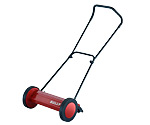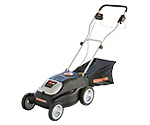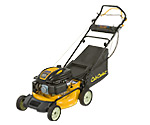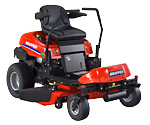Types
Mowing options range from $100 manual reel mowers to $4,000-plus tractors and zero-turn-radius machines. Here are the types of lawn mowers and tractors to consider.
Manual-reel mowers
These most traditional of mowers don't pollute--and you won't need to store gas or a power cord. Pushing them turns a series of curved blades. Because they have no engine, they're also quiet and inexpensive, relatively safe, and require little upkeep beyond blade adjustments and sharpening. Some models use a battery-powered motor to spin the blades while you push the mower. But swaths are typically 14 to 18 inches wide, cutting tends to be uneven, and most can't cut taller than 1½ inches or trim closer than 3 inches around obstacles. They don't disburse clippings like a rotary mower, so you'll need a bag (or a rake) if you're fussy.

Electric push-type mowers
These walk-behind mowers are good for small, level lawns. They use an electric motor to turn a rotating blade and, for some, drive the wheels. Cordless mowers weigh up to 30 pounds more than corded models, but they can roam farther from a power outlet and free you from a cord. Cords are a potential problem on lawns with trees and other obstacles. Today's cordless models run longer per charge than previous models. Cord and cordless types start with push-button ease, produce no exhaust emissions at the machine, and require little upkeep beyond blade sharpening. Most offer a side or rear bag and a mulching mode that cuts clippings finely enough that they settle within the lawn and fertilize it as they decompose. The best electrics perform as well as some gas mowers, but they can't match the best gas machines in tall or thick grass and weeds. Electrics typically cut an 18- to 20-inch swath.

Gas-powered mowers
These include push and self-propelled models. Most have a four-stroke engine with a 160- to 190-cubic-centimeter displacement, a measure that has replaced horsepower ratings. Some also list torque, or twisting force. Most cut a 21- or 22-inch swath, can handle long or thick grass and weeds, and can bag, side-discharge, and mulch clippings. Self-propelled models are best for most lawns and blend ease and performance. But gas mowers are noisy and produce exhaust emissions--though today's models emit less than those of the past--and the engine requires regular tune-ups and oil changes.

Lawn tractors
These front-engine machines often cost less than the older and smaller rear-engine riders. Most mow a 42- to 48-inch swath and can bag, mulch, and side-discharge clippings. Some cut an even wider swath and offer four-wheel steering for tighter turns. All accept snow throwers and other tools. But even today's cleaner machines create exhaust emissions and still require about 4 by 6 feet of storage space. Snow blowers and some other add-ons are pricey and hard to install and remove.

Zero-turn-radius mowers
These riding mowers are similar to the ones landscapers use, with a rear-engine and rear-wheel steering. Maneuverability is their strong suit. Some have steering wheels though most have twin steering levers let you power the two rear wheels individually; with one wheel in forward and the other in reverse, they can turn circles in one place. They can also side-discharge, bag, and mulch clippings. Typically, they mow a 42- to 48-inch swath. But they cost more than most tractors and typically don't cut as well overall. Their rear-steering wheels can tear up grass during turns. They can lose traction and be hard to steer and control on hills, and their lever controls for steering and ground speed require practice. For a large lawn with lots of obstacles, consider a four-wheel-steer tractor. You'll also find more two-wheel-steer tractors with narrower turning circles than before.

Robotic mowers
Rising sales of robotic cordless vacuum cleaners have spawned robotic electric mowers, which buzz along on their own--typically within a perimeter wire that sets the mowing boundaries. They're designed to crisscross randomly, reverse direction when they reach the wire or an obstacle, and return to a charging station when necessary. These niche machines produce no emissions at the source, but their performance varies widely. Cut quality is often less than a conventional mower's. Robotic mowers are expensive and should be supervised. Indeed, manufacturers often warn you to keep children and pets away while the machine is running.






